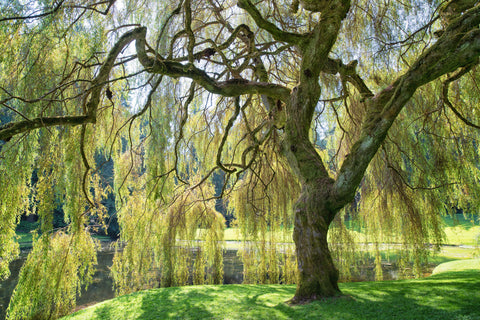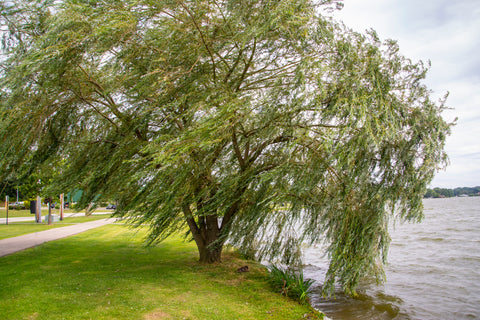Weeping willows enchant every space they’re in. With silver-green canopies and dancing branches, these trees are like no other. And as one of the first to bloom in late winter, their caterpillar-like flowers provide whimsical early spring interest.
As such an iconic tree, the weeping willow is the subject of much discussion in the plant world. But with that popularity comes misinformation. That’s why we’ve consulted our plant experts to help break down the most common questions about the weeping willow.
Read on to get accurate, consolidated information about this tree, its care needs, and whether it would be a good fit for your yard!
Weeping Willow General Facts
1. Are all willow trees weeping?
There are several willow varieties that take on a traditional tree or bush shape rather than the drooping umbrella shape. Most willows, weeping or not, can be distinguished by their thin, wispy branches and their long, silvery leaves.
2. How fast does the weeping willow grow?
Weeping willows will grow, on average, 3-4 feet each year. Although weeping willows may seem slow growing, they actually grow very quickly–one of the fastest-growing trees available! They’re also ideal as shade trees, with leaves that sprout first in spring and hold until frost. And the more water available to your weeping willow, the faster it will grow.
3. What is the average lifespan of the weeping willow?
Ever wondered how long a weeping willow tree will live? There seems to be a misconception that weeping willow trees are fragile and don’t survive long. But fortunately, the fairytale weeping willow can live up to 30 years.
Care for the Weeping Willow
4. Where should you grow a weeping willow?
Weeping willows are most commonly found planted near ponds or damp areas, but a water feature isn’t a requirement. It’s more important for a weeping willow tree to receive full sun to partial shade and to be planted in slightly acidic, moist soil. Even if you don’t have a pond, as long as it gets enough water and sun, your weeping willow tree will thrive.
5. What time of the year do you plant a weeping willow tree?
It is a general rule that most trees will establish more quickly if planted in late spring or early fall. However, as long as the weeping willow is planted 6 weeks before the predicted first frost in your growing zone, it should establish well (zones 4-10). If you’re planting in the warmer months, simply water the tree more frequently.
6. How to make a weeping willow tree grow faster?
Contrary to belief, weeping willow trees are one of the trees that grow fast, especially when they’re in optimal conditions. So, how can you help your weeping willow grow more quickly? First, plant your tree in a location where it will get as much sun as possible. Secondly, plant it in slightly acidic soil that is also moist (but not too soggy). To create more well-draining soil, you may mix sand into the soil while planting.

As we said before, your weeping willow tree will grow faster with more water. If you can, plant it near a water feature. If no pond or stream is available, be sure to keep the soil moist 2 inches down by watering regularly. Lastly, although it is not required, you may use a balanced fertilizer to boost your weeping willow’s growth and health.
Weeping Willow Concerns
7. Do weeping willows have problems?
As with any plant, there are pros and cons to having a weeping willow tree in your landscape. Because weeping willows are generally planted and thrive in damp locations, they are susceptible to mildew, fungi, and root rot. However, all of these conditions can be avoided or treated by removing infected sections of the tree. Disease in weeping willows isn’t very common.
Weeping willows can be prone to breakage because of their flexible wood. Therefore, consider skipping this tree if you live in an extremely windy area. Instead, for a similar look you could plant the fast-growing hybrid willow or a weeping cherry.

8. Are weeping willow trees messy?
There is some truth that weeping willows can be considered messy, occasionally dropping branches after a strong wind. You might find yourself picking up sticks every few weeks or before mowing the lawn. But while there are many trees that aren’t as messy, none of them can compare to the gorgeous appeal of the weeping willow.
9. Is the weeping willow tree invasive?
The weeping willow has a strong and vast root system. Unfortunately, this root system can be considered invasive. It is advised not to plant this tree near pools or homes to ensure those structures aren’t impacted by the roots. Plant your weeping willow at least 50 feet away from main structures, pathways, or driveways.
Why does the weeping willow root system expand so widely? This tree, and its root system, seeks water. So the roots branch out in all directions seeking water and will grow more dense in areas where water has been found. So drainage pipes, pools, and ponds will be densely packed with roots within a short period of time.
Weeping Willows for Your Landscape
For better or worse, we love the weeping willow. You can bring this timeless tree to your space to quickly enjoy the shade and beauty of its silver of a canopy of silvery foliage. Check out these customer favorites, including the original Weeping Willow and the Corkscrew Willow Tree.


